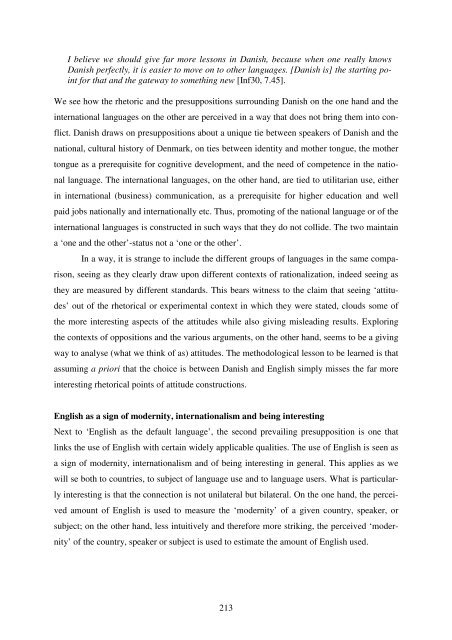Hør dog hvad de siger - Note-to-Self: Trials & Errors
Hør dog hvad de siger - Note-to-Self: Trials & Errors
Hør dog hvad de siger - Note-to-Self: Trials & Errors
Create successful ePaper yourself
Turn your PDF publications into a flip-book with our unique Google optimized e-Paper software.
I believe we should give far more lessons in Danish, because when one really knows<br />
Danish perfectly, it is easier <strong>to</strong> move on <strong>to</strong> other languages. [Danish is] the starting point<br />
for that and the gateway <strong>to</strong> something new [Inf30, 7.45].<br />
We see how the rhe<strong>to</strong>ric and the presuppositions surrounding Danish on the one hand and the<br />
international languages on the other are perceived in a way that does not bring them in<strong>to</strong> con-<br />
flict. Danish draws on presuppositions about a unique tie between speakers of Danish and the<br />
national, cultural his<strong>to</strong>ry of Denmark, on ties between i<strong>de</strong>ntity and mother <strong>to</strong>ngue, the mother<br />
<strong>to</strong>ngue as a prerequisite for cognitive <strong>de</strong>velopment, and the need of competence in the natio-<br />
nal language. The international languages, on the other hand, are tied <strong>to</strong> utilitarian use, either<br />
in international (business) communication, as a prerequisite for higher education and well<br />
paid jobs nationally and internationally etc. Thus, promoting of the national language or of the<br />
international languages is constructed in such ways that they do not colli<strong>de</strong>. The two maintain<br />
a ‘one and the other’-status not a ‘one or the other’.<br />
In a way, it is strange <strong>to</strong> inclu<strong>de</strong> the different groups of languages in the same compa-<br />
rison, seeing as they clearly draw upon different contexts of rationalization, in<strong>de</strong>ed seeing as<br />
they are measured by different standards. This bears witness <strong>to</strong> the claim that seeing ‘attitu-<br />
<strong>de</strong>s’ out of the rhe<strong>to</strong>rical or experimental context in which they were stated, clouds some of<br />
the more interesting aspects of the attitu<strong>de</strong>s while also giving misleading results. Exploring<br />
the contexts of oppositions and the various arguments, on the other hand, seems <strong>to</strong> be a giving<br />
way <strong>to</strong> analyse (what we think of as) attitu<strong>de</strong>s. The methodological lesson <strong>to</strong> be learned is that<br />
assuming a priori that the choice is between Danish and English simply misses the far more<br />
interesting rhe<strong>to</strong>rical points of attitu<strong>de</strong> constructions.<br />
English as a sign of mo<strong>de</strong>rnity, internationalism and being interesting<br />
Next <strong>to</strong> ‘English as the <strong>de</strong>fault language’, the second prevailing presupposition is one that<br />
links the use of English with certain wi<strong>de</strong>ly applicable qualities. The use of English is seen as<br />
a sign of mo<strong>de</strong>rnity, internationalism and of being interesting in general. This applies as we<br />
will se both <strong>to</strong> countries, <strong>to</strong> subject of language use and <strong>to</strong> language users. What is particular-<br />
ly interesting is that the connection is not unilateral but bilateral. On the one hand, the percei-<br />
ved amount of English is used <strong>to</strong> measure the ‘mo<strong>de</strong>rnity’ of a given country, speaker, or<br />
subject; on the other hand, less intuitively and therefore more striking, the perceived ‘mo<strong>de</strong>r-<br />
nity’ of the country, speaker or subject is used <strong>to</strong> estimate the amount of English used.<br />
213



